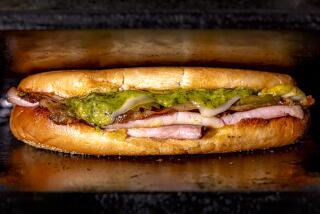Fred Harvey Served Up Railroad Dining’s Golden Age
- Share via
SAN FRANCISCO — The quality of railroad dining has come full circle, from short stops for bad food in the pioneer days to Amtrak’s vending machines and snack bars.
No four-star ratings then or now. But in between, dining while riding the rails became synonymous with elegance, thanks largely to a man named Fred Harvey.
Harvey was 15 and almost broke when he arrived in New York from England in 1850. His first job--a lowly dishwasher.
But Harvey was so ambitious that by the time he died in 1901 he had built a food empire that helped tame the West, according to a new book.
Authors Peter Weiglin of San Mateo, about a 30-minute train ride from San Francisco, and George Foster of Tucson, Arizona, have recounted Harvey’s exploits in “The Harvey House Cookbook,” (Longstreet Press, $18.95).
Starting in the 1870s, Harvey set up first-class restaurants along the route of the Santa Fe Railroad, made dining cars palatial rolling restaurants and brought the famous “Harvey Girls” to the West.
“I wanted to remind people of a real American tradition,” Weiglin said of the Harvey establishments that disappeared in the early 1970s as Amtrak took over the railroads.
Weiglin, 54, recalled eating in the Harvey House in Cleveland when he was just a lad.
“I remember it well and also the fine food I ate as an adult when Harvey supplied food to Frontier Airlines. The airline food was the finest around,” he said.
The book recounts Harvey’s culinary exploits and provides more than 200 recipes, many of them simple to prepare.
A warning, though. The Harvey House Cookbook is hardly a modern cookbook in which recipes are precise, almost clinical, sometimes carried down to grams and globules. Older recipes often just list the ingredients in a dish.
But they are easy, so easy a man can handle them, even though Harvey had plenty of trouble with male workers.
A brawl at the Raton, N.M.,, Harvey House in 1883 left male waiters hors de combat. Harvey fired the lot and ads soon appeared in newspapers seeking “young women, 18 to 30 years, of good character, attractive and intelligent.”
The candidates’ “past private lives were probed to an extent that would bring on an avalanche of civil rights lawsuits against personnel departments today,” the book says.
One liability to hiring attractive women was the good chance they would marry and quit. Waitresses had to sign contracts for a year’s service.
Thousands of Harvey Girls ended their restaurant careers by marrying and helping civilize the West.
“The retired Harvey Girls were at the forefront of civic improvement activities of all kinds, and the communities flourished in ways that they never would have had the job been left to men alone,” the authors contend.
More to Read
Eat your way across L.A.
Get our weekly Tasting Notes newsletter for reviews, news and more.
You may occasionally receive promotional content from the Los Angeles Times.










